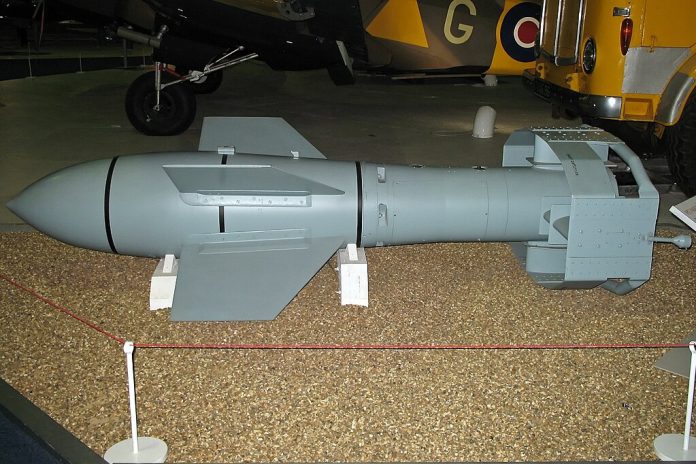
How does a 250-kilogram-class bomb become one of the most persistent threats over Ukraine’s skies? The answer lies in the UMPB D-30SN a purpose-built Russian glide munition whose design, deployment platforms, and supply chain reveal as much about modern weapons engineering as they do about the global networks sustaining Moscow’s war effort.

1. From FAB-250 to Precision Glide Weapon
The UMPB D-30SN is not a retrofit kit like the earlier UMPK but a dedicated glide bomb built around a warhead equivalent to the FAB-250. Measuring roughly 30 cm in diameter and carrying over 100 kilograms of explosives, it integrates the S.M.A.R.T. autopilot module and employs inertial navigation augmented by the Kometa-M8 controlled reception pattern antenna (CRPA). This eight-element adaptive antenna array is designed to resist jamming by detecting and rejecting false GNSS signals, a critical feature in Ukraine’s dense electronic warfare environment.

2. Range and Aerodynamic Advantage
Field analysis, including trajectory mapping from Belgorod-region launches toward Kharkiv, suggests an autonomous flight range of about 90 kilometers 20–30 km farther than UMPK-equipped FAB-500s. Its monoplane wing and tail configuration offer greater aerodynamic efficiency than the biplane concepts patented by GNPP Region in 2021–2022, enabling standoff launches from altitudes of 12–15 km. This range allows Russian aircraft to remain outside many Ukrainian air defense envelopes.

3. Deployment Platforms: From Strike Jets to Stealth UAVs
The munition is cleared for carriage by Su-34, Su-30SM, Su-35, and Su-24 aircraft, as well as the S-70 Okhotnik-B unmanned combat air vehicle. The Okhotnik’s internal weapons bay a necessity for maintaining low radar cross-section cannot accommodate bulkier UMPK-modified bombs, making the UMPB D-30SN the preferred precision payload. There are also reports of compatibility with 300 mm Tornado-S multiple-launch rocket systems when fitted with a booster motor, hinting at a potential ground-launched role akin to the U.S. GLSDB concept.

4. Combat Use and Production Rates
Since its first recorded use in March 2024, the UMPB D-30SN has been employed in repeated strikes on Kharkiv and other northeastern Ukrainian targets. Serial number analysis of recovered munitions indicates that between late March and early May 2024, Russia produced at least 671 units averaging over 16 per day with output likely increasing. Su-34s typically carry three to four bombs per sortie, constrained by the absence of a BRU-61/A-style multiple carriage system.

5. Guidance Systems and Countermeasures
The Kometa-M8 CRPA module represents Russia’s latest effort to harden glide bombs against Ukrainian EW systems such as the “Lima,” which uses digital suppression, spoofing, and cyber interference to degrade accuracy. The UMPB’s hybrid guidance allows it to continue on inertial data if satellite lock is lost, though accuracy degrades over distance. Russian industry has already integrated similar CRPA upgrades into UMPK kits as of April 2025, marking a broader trend toward multi-channel, jam-resistant navigation.

6. Supply Chain Under Sanctions Pressure
The patent holder, Tactical Missile Armament Corporation, and principal manufacturer, Concern Granit-Electron JSC, rely on a network of at least 36 cooperating companies. Many are sanctioned, yet Ukrainian intelligence notes that some suppliers remain unsanctioned and continue sourcing foreign components. U.S. State Department designations in 2024 exposed a procurement network delivering 80,000 PRC-origin servo motors worth $200 million for glide bomb production, funneled through Russian firms like OMNITRADE and SV POLIMER from suppliers in Shenzhen and Hong Kong.

7. Chinese and Third-Country Contributions
Investigations reveal that CNC machine tools, microelectronics, and other Common High Priority List items flow from PRC-based manufacturers such as Zhejiang Kaida Machine Tool and Dongguan Jetland Supply Chain Management to Russian defense plants. Similar supply chains have sustained missile production at the Votkinsk Plant, circumventing sanctions via intermediaries in Türkiye, Malaysia, and the UAE. These imports fill critical gaps in Russia’s manufacturing cycle, enabling sustained output of precision munitions despite embargoes.

8. Strategic Implications of UAV Integration
The S-70 Okhotnik’s pairing with the UMPB D-30SN demonstrates Russia’s intent to merge stealth UAV platforms with precision standoff strike capabilities. This combination reduces risk to aircrews and could extend strike reach deeper into Ukrainian territory. However, the October 2024 friendly-fire downing of an armed Okhotnik followed by an Iskander missile strike to destroy wreckage exposed vulnerabilities in control systems and underscored the sensitivity of onboard technology.

9. Engineering Choices and Operational Trade-offs
Unlike the U.S. GBU-39/B Small Diameter Bomb, which benefits from quad-carriage racks, the UMPB’s single-pylon integration limits sortie efficiency. Yet its smaller size compared to 500–1,500 kg bombs offers reduced collateral damage and allows deployment from a wider range of aircraft. The design reflects a compromise between cost, range, and precision, shaped by Russia’s urgent need for mass-producible standoff munitions in a contested airspace.
The UMPB D-30SN’s evolution from design refinements and EW-hardened guidance to stealth UAV integration illustrates how Russia is adapting its aerial strike toolkit under wartime pressure. Its supply chain, stretching from sanctioned Russian firms to Chinese machine tool exporters, reveals the resilience of globalized manufacturing in sustaining advanced weapons programs even under unprecedented sanctions.


